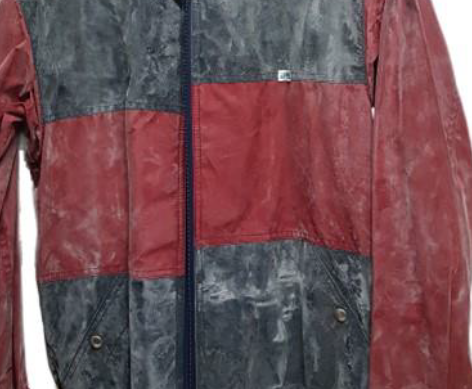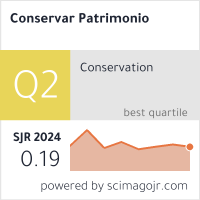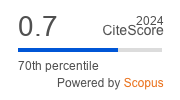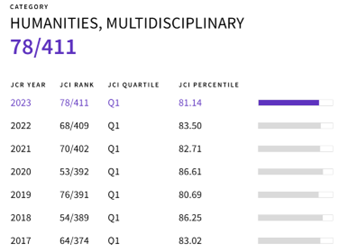A preliminary approach for blooming removal in polyurethane-coated fabrics
DOI:
https://doi.org/10.14568/cp34728Keywords:
White deposits, Cleaning, Adipic acid, Thermoplastic polyurethane, Coatings, Fashion and designAbstract
Coated fabrics with thermoplastic polyurethane (TPU) are largely found in fashion and design collections in imitation leathers and glossy-look fabrics. Unfortunately, blooming is a common damage in aged TPU, appearing as white crystalline deposits at the surface. These deposits have been generally identified as adipic acid and mainly affect ester-based aromatic TPU. The white colour of adipic acid often leads to the complete unrecognition of the cultural item, highly decreasing its values. Strategies to remove blooming are still absent in the literature, resulting in a lack of action by conservators. The Glossy Surfaces project addressed this issue through preliminary research on cleaning strategies to remove adipic acid. Dry and wet methods were tested on two fabrics showing blooming and different surface cohesion. Non-confined and confined liquids in hydrogels were included and assessed by digital microscopy, colourimetry, and infrared spectroscopy. The best results were achieved with agar-agar, but limitations were also recognized.
Downloads
References
Puglieri, T. S.; Lavezzo, A. S.; dos Santos, I. F.; de Faria, D. L. ‘Investigation on the hazing of a Brazilian contemporary painting’, Spectrochimica Acta Part A: Molecular and Biomolecular Spectroscopy 159 (2016) 117-122, https://doi.org/10.1016/j.saa.2016.01.035.
Bartl, B.; Kobera, L.; Drábková, K.; Ďurovič, M.; Brus, J., ‘Wax bloom’on beeswax cultural heritage objects: Exploring the causes of the phenomenon’, Magnetic Resonance in Chemistry 53(7) (2015) 509-513, https://doi.org/10.1002/mrc.4244.
Krieg, T.; Mazzon, C.; Gómez-Sánchez, E., ‘Material analysis and a visual guide of degradation phenomena in historical synthetic polymers as tools to follow ageing processes in industrial heritage collections’, Polymers 14(1) (2021) 121, https://doi.org/10.3390/polym14010121.
Lavédrine, B.; Fournier, A.; Martin, G. (eds.), POPART: Preservation of plastic artefacts in museum collections, Comité Des Travaux Historiques Et Scientifiques (CTHS), Paris (2012).
França de Sá, S.; Verkens, K.; Rizzo, A.; Petersen, G.; Scaturro, S.; Correia, I.; Carita, M., ‘Synthetic coatings in fashion collections: identification and preservation issues’, in Handbook of museum textiles, eds. S. Jose, S. Thomas, P. Pandit & R. Pandey, vol 2, Scrivener Publishing LLC, Hoboken (2023) 319-344, https://doi.org/10.1002/9781119983903.
Rizzo, A.; Scaturro, S., ‘Already out of fashion: The fashionable rise and chemical fall of thermoplastic polyurethane’, in Transcending boundaries: integrated approaches to conservation. ICOM-CC 19th Triennial Conference Preprints, ed. J. Bridgland, ICOM-CC, Beijing (2021), ICOM-CC Publications Online (icom-cc-publications-online.org) (accessed 25-07-2024).
França de Sá, S.; Ferreira, J. T.; van der Velde, E.; Correia, I.; Rizzo, A.; Verkens, K., ‘Mapping polyurethane coated fabrics and damages in fashion collections worldwide by optical microscopy and infrared spectroscopy’, in Semi-synthetic and synthetic textile materials in fashion, design and art, ICOM-CC Modern Materials & Contemporary Art and Textiles Working Groups Joint Interim Meeting 21-23 Feb 2023, submitted (n.d.).
França de Sá, S.; Ramos, A. M.; Macedo, R.; Ferreira, J. L.; Coutinho, B., ‘How to keep what was intended to be temporarily functional? Reflections on decision-making for the conservation of polyurethane ready-to-wear fashion’, in Authenticity and Replication the ‘real thing’ in art and art conservation, eds. R. Gordon, E. Hermens & F. Lennard, Archetype Publications, London (2014) 193-203.
Rychlý, J.; Lattuati-Derieux, A.; Lavédrine, B.; Matisová-Rychlá, L.; Malíková, M.; Csomorová, K.; Janigová I., ‘Assessing the progress of degradation in polyurethanes by chemiluminescence and thermal analysis. II. Flexible polyether-and polyester-type polyurethane foams’, Polymer Degradation and Stability 96 (2011) 462-469, https://doi.org/10.1016/j.polymdegradstab.2011.01.012.
Lattuati-Derieux, A.; Thao-Heu, S.; Lavédrine B., ‘Assessment of the degradation of polyurethane foams after artificial and natural ageing by using pyrolysis-gas chromatography/mass spectrometry and headspace-solid phase microextraction-gas chromatography/mass spectrometry’, Journal of Chromatography A 1218(28) (2011) 4498-4508, https://doi.org/10.1016/j.chroma.2011.05.013.
Schollenberger, C. S.; Stewart, F. D., ‘Thermoplastic polyurethane hydrolysis stability’, Journal of Elastoplastics 3(1) (1971) 28-56, https://doi.org/10.1177/009524437100300103.
Mondal, S.; Martin, D., ‘Hydrolytic degradation of segmented polyurethane copolymers for biomedical applications’, Polymer degradation and stability 97(8) (2012) 1553-1561, https://doi.org/10.1016/j.polymdegradstab.2012.04.008.
Meckel, W.; Goyert, W.; Wieder, W., ‘Thermoplastic Polyurethane Elastomers’, in Thermoplastic Elastomers, eds. G. Holden, N.R. Legge, R. Quirk & H.E. Schroeder, 2nd ed, Carl Hanser Verlag, Munich (1996) 16-17.
Yilgör, I.; Yilgör, E.; Wilkes, G. L., ‘Critical parameters in designing segmented polyurethanes and their effect on morphology and properties: a comprehensive review’, Polymer 58 (2015) A1-A36, https://doi.org/10.1016/j.polymer.2014.12.014.
BASF SE, Soft thermoplastic polyurethane elastomers and process for their preparation, European Patent Office, patent number EP3004198A1, Germany, BASF SE (2016).
Pellizzi, E.; Lattuati-Derieux, A.; Lavédrine, B.; Cheradame C., ‘Degradation of polyurethane ester foam artifacts: Chemical properties, mechanical properties and comparison between accelerated and natural degradation’, Polymer Degradation and Stability 107 (2014) 255-261, https://doi.org/10.1016/j.polymdegradstab.2013.12.018.
Pellizzi, E.; Lattuati-Derieux, A.; d'Espinose de Lacaillerie, J-B.; Lavédrine, B.; Cheradame, H., ‘Consolidation of artificially degraded polyurethane ester foam with aminoalkylalkoxysilanes’, Polymer Degradation and Stability 129 (2016) 106-113, https://doi.org/10.1016/j.polymdegradstab.2016.04.007.
Bechthold, T.; Rogerson, C.; Garside, P., ‘Wet look in 1960s furniture design: degradation of polyurethane-coated textile carrier substrates’, in The future of the 20th century, collecting, interpreting and conserving modern materials. Postprints of AHRC Research Centre for Textile Conservation and Textile Studies, ed. C. Rogerson & P. Garside, Archetype Publications, London (2006) 128-133.
Schertel, B., Polyurethane-coated textiles found on furniture from the 1960s and 1970s: their manufacture, deterioration and consolidation; Master dissertation, Furniture Conservation, Victoria & Albert Museum / Royal College of Art, London (2006).
Gaivoronskii, A. N.; Granzhan, V. A., ‘Solubility of adipic acid in organic solvents and water’, Russian journal of applied chemistry 78(3) (2005) 404-408, https://doi.org/10.1007/s11167-005-0305-0.
Zhibo, M.; Xiaobo, S.; Xianghai, L.; Yu, W.; Guoji, L., ‘Measurement and correlation of solubilities of adipic acid in different solvents’, Chinese Journal of Chemical Engineering 17(3) (2009) 473-477, https://doi.org/10.1016/S1004-9541(08)60233-5.
BASF Polyurethanes GmbH, ‘Thermoplastic Polyurethane Elastomers (TPU) Elastollan® – Chemical Resistance’, in Technical Information (2011), https://www.campusplastics.com/file/show/59/0/5e_TPU_ChemRes.pdf (accessed 2024-02-20).
Daudin-Schotte, M.; van Keulen, H., ‘Dry cleaning: research and practice’, in Issues in contemporary oil paint, eds. K. van den Berg, A. Burnstock, M. de Keijzer, T. Learner, A. Tagle & G. Heydenreich, Springer International Publishing Switzerland, Switzerland (2014) 363-372, https://doi.org/10.1007/978-3-319-10100-2_24.
Sansonetti, A.; Bertasa, M.; Canevali, C.; Rabbolini, A.; Anzani, M.; Scalarone, D., ‘A review in using agar gels for cleaning art surfaces’, Journal of Cultural Heritage 44 (2020) 285-296, https://doi.org/10.1016/j.culher.2020.01.008.
Casoli, A.; Cremonesi, P.; Isca, C.; Groppetti, R.; Pini, S.; Senin, N., ‘Evaluation of the effect of cleaning on the morphological properties of ancient paper surface’, Cellulose 20 (2013) 2027-2043, https://doi.org/10.1007/s10570-013-9975-6.
Giordano, A.; Caruso, M. R.; Lazzara, G., ‘New tool for sustainable treatments: agar spray–research and practice’, Heritage Science 10(1) (2022) 123, https://doi.org/10.1186/s40494-022-00756-9.
Shashoua, Y.; Alterini, M.; Pastorelli, G.; Cone, L., ‘From microfibre cloths to poly (vinyl alcohol) hydrogels–conservation cleaning of plastics heritage’, Journal of Cultural Heritage 52 (2021) 38-43, https://doi.org/10.1016/j.culher.2021.08.009.
Angelova, L. V.; Sofer, G.; Bartoletti, A.; Ormsby, B., ‘A comparative surface cleaning study of op structure, an op art PMMA sculpture by Michael Dillon’, Journal of the American Institute for Conservation 62(1) (2023) 58-77, https://doi.org/10.1080/01971360.2022.2031459.
Domingues, J.; Bonelli, N.; Giorgi, R.; Fratini, E.; Gorel, F.; Baglioni, P., ‘Innovative hydrogels based on semi-interpenetrating p(HEMA)/PVP networks for the cleaning of water-sensitive cultural heritage artefacts’, Langmuir 29(8) (2013) 2746-2755, https://doi.org/10.1021/la3048664.
Domingues, J.; Bonelli, N.; Giorgi, R.; Fratini, E. B. P, ‘Innovative method for the cleaning of water-sensitive artifacts: synthesis and application of highly retentive chemical hydrogels’, International Journal of Conservation Science 4 (special issue) (2013) 715-722, Article (ijcs.ro) (accessed 2024-07-25).
Pujari, J.; Pushpalatha, S.N.; Desai, P.D., ‘Content-based image retrieval using color and shape descriptors’, International Conference on Signal and Image Processing, Chennai, India (2010) 239-242, https://doi.org/10.1109/ICSIP.2010.5697476.
Kang, S.; Xing, B., ‘Adsorption of dicarboxylic acids by clay minerals as examined by in situ ATR-FTIR and ex situ DRIFT’, Langmuir 23(13) (2007) 7024-7031, https://doi.org/10.1021/la700543f.
Kirwan, L. J.; Fawell, P. D.; van Bronswijk, W., ‘In situ FTIR-ATR examination of poly (acrylic acid) adsorbed onto hematite at low pH’, Langmuir 19(14) (2003) 5802-5807, https://doi.org/10.1021/la027012d.
Kwak, H. S.; Lee, J. E.; Chang, Y. H., ‘Structural characterisation of β‐cyclodextrin crosslinked by adipic acid’, International journal of food science & technology 46(6) (2011) 1323-1328, https://doi.org/10.1111/j.1365-2621.2011.02594.x.
Mouanni, S.; Amitouche, D.; Mazari, T.; Rabia, C., ‘Transition metal-substituted Keggin-type polyoxometalates as catalysts for adipic acid production’, Applied Petrochemical Research 9 (2019) 67-75, https://doi.org/10.1007/s13203-019-0226-0.
Tomás Ferreira, J.; Damas, C.; Carita, M.; Correia, I.; van der Velde, E.; Verkens, K.; França de Sá, S., ‘OH NO, NOT BLOOMING AGAIN! Assessing the influence of storage conditions in the reappearance of blooming on TPU coated fabrics’, poster, in Future Talks 023: Materials Matter. Cold and Current Cases in the Conservation of the Modern, Munich (2023).

Downloads
Published
How to Cite
Issue
Section
Categories
License
This work is distributed under a Creative Commons Attribution License (CC BY-NC-ND 4.0) which permits use, distribution, and reproduction in any medium following no commercial or derivatives, provided the original author and source are credited.
Copyright remains with the authors.






